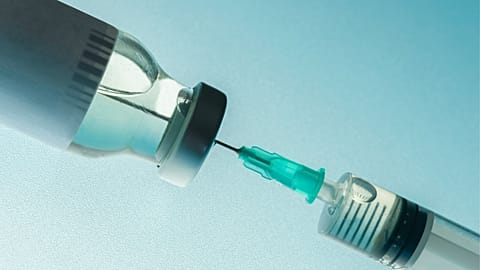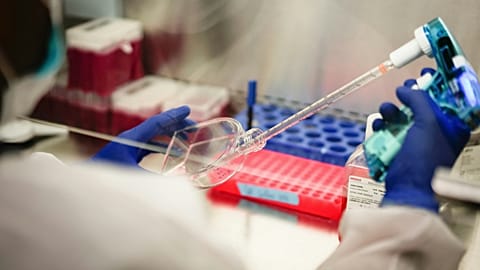A new menopause drug called Veozah targets the brain, not hormones, to relieve women suffering from hot flashes.
With the world’s ageing population, it is estimated that 1.2 billion women will be menopausal or postmenopausal by the year 2030.
Out of the 1.2 billion, as much as 85 per cent will likely experience debilitating symptoms, including hot flashes (also known as hot flushes) and night sweats, but also chronic insomnia, depression, increased risk of blood clots, stroke, and osteoporosis.
Menopause - defined as the cessation of menstruation for at least 12 successive months, which typically occurs between the ages of 45 and 55 - is understudied, partly due to the disparity in funding for research on women’s health compared with men’s.
But a new treatment offers hope. Earlier this month, the US Food and Drug Administration approved the first non-hormonal therapy to treat the source of hot flashes in menopausal women.
Fezolinetant, which was developed by Astellas Pharma and will be sold in the United States under the brand name Veozah, is the first to target a neuron in the brain that changes behaviour as oestrogen levels drop.
The drug had been under priority review by the FDA, and Dr Ami P. Raval, who studies women's reproduction systems and brain health at the University of Miami in Florida, says it could be a game changer.
She expects the drug to encourage the scientific community to pursue more research in this field, “which is oftentimes a victim of social stigma”. “People don't feel very comfortable talking about menopause,” she told Euronews Next.
The limits of HRT for menopause
There is already a cheap and effective alternative to help women through the debilitating symptoms of menopause: hormone-replacement therapy (HRT). But the treatment is not risk-free and some women are not eligible, particularly those who are at risk of blood clots or who have had breast cancer.
HRT has also been the victim of decades of ongoing controversy, scaring many women from using it due to potential links with hormone-dependent cancers, stroke and venous thromboembolism.
Today, the knowledge around HRT has greatly improved, and newer studies have shown that the risks associated with taking hormonal supplementation vary depending on factors such as age, the type of HRT used, and the length of time a woman takes hormonal therapy.
But the improved understanding of the risks and benefits of hormonal therapy has not clouded the excitement over a new drug that would finally offer a hormone-free alternative to manage menopausal symptoms.
The challenge with HRT is not to overburden women’s normal physiology, Raval said. “You don't want to give all oestrogen functions a boost - stimulating the breasts, for example - especially at a time when women’s bodies are supposed to undergo an oestrogen decline,” she explained.
If you are to target the brain, then you have to target something which is brain-specific. Fezolinetant does just that.
What is fezolinetant and how does it work on the brain?
The development of fezolinetant owes a lot to the research of Dr Naomi Rance, a now-retired neuropathologist from the University of Arizona who started studying the relationship between the brain and menopause in the early 1990s.
In her research with post-mortem organs, Rance decided to compare a region of the brain called the hypothalamus in pre-and post-menopausal women and see what was going on there.
"And what we found… were remarkable changes,” she said during a conference at the University of Arizona.
The discovery was a “career-defining moment,” she said: “There was a group of neurons that got bigger… and these weren't just any neurons getting bigger… They were the neurons that express oestrogen reception, and they were getting bigger because of oestrogen withdrawal”.
Oestrogen withdrawal is a term used to describe the decrease in oestrogen levels that occurs during menopause.
Scientists had known for some time that the decline in ovarian hormones during menopause correlated with the incidence of hot flashes. However, it was Rance who first pointed out that the sensation of hot flashes was due to changes in a neural network in the brain.
Rance continued pulling the thread of her experiments by studying menopause symptoms in rats and tracking tiny temperature changes in their tails as a measure of hot flashes.
The subtle temperature changes in mice helped her to establish in 2011 that activating the receptor for a molecule called neurokinin B in rats triggered hot-flash-like changes.
Rance’s work then caught the attention of other scientists, among them Turkish professor Asli Topaloglu-Ak, who later identified the cellular receptor of neurokinin B, which ultimately allowed to target new, potential medicines to modulate the neural network Rance discovered.
Rance set the groundwork, and Topaloglu-Ak’s “inspired the research culminating in the discovery of fezolinetant,” the researchers wrote in a review article of the drug since developed by Astellas Pharma.
The FDA had granted fezolinetant priority review and said the pill proved effective to treat moderate to severe hot flashes in two randomised, placebo-controlled, double-blind phase 3 clinical trials that each lasted a year.
“The introduction of a new molecule to treat moderate to severe menopausal hot flashes will provide an additional safe and effective treatment option for women,” Dr Janet Maynard, of the FDA’s Center for Drug Evaluation and Research, said in a statement.
Taking women’s health more seriously
For Raval, fezolinetant’s introduction to the drug market is a sign that research into women’s health is being taken more seriously.
There is a male bias in the scientific world, she said, and the field of science tends to be more geared towards men or male experimental animals because, simply, “it is very complex to study females”.
For example, if a woman suffered a stroke, “you need to know whether she was on an oral contraceptive, whether she was on hormone replacement therapy, whether she was pregnant when she was young with one baby or several babies, you want to know if she had a migraine and if she had polycystic ovaries,” Raval explained.
“But in the case of men, these components are not there”.
Our knowledge about menopause is also limited because other animals don’t experience it. Only a few species of whale undergo natural menopause as humans do.
Understanding perimenopause: The future of menopause research
The gradual shutdown of ovarian function, called perimenopause, could hold the key to many more discoveries, says Raval.
“This slow and steady progress towards menopause brings turbulence for women’s bodies because of the slow decline of oestrogen levels, which the brain and all the body is used to receiving,” she said.
Easing perimenopause - including by taking some kind of replacement therapy - could therefore make subsequent menopausal changes and their consequences less severe, she added.
Understanding this debilitating stage could even help determine women's brain health in later life.
“Perimenopause brings in a kind of systemic inflammation - oestrogen is one of the regulators of inflammation in the body - and this inflammation is thought to be related to some neurodegenerative diseases later on in life,” Raval explained.
“Women develop Alzheimer's disease more than men, and they also experience more mild cognitive decline. However, this could be reduced if we started treating them during the menopause transition, which is the most important time in a woman’s life”.


















